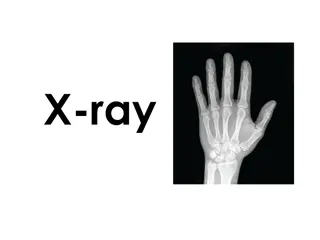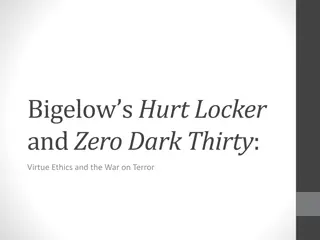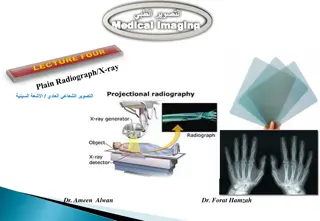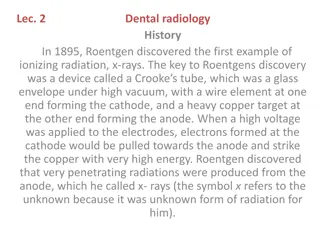Understanding X-Ray Films: Composition and Classification
This detailed content explores X-ray films, covering elements such as emulsion, base foundation, supercoat, and protective layers. Learn about the intricate composition of X-ray film packets, the role of lead foil and black wrappers, and the classification of intraoral and extraoral X-rays like IOPA, Bitewing, and Occlusal. Dive into the specifics of sizes for different dental X-rays and gain insights into the crucial components that make up these essential diagnostic tools.
Download Presentation

Please find below an Image/Link to download the presentation.
The content on the website is provided AS IS for your information and personal use only. It may not be sold, licensed, or shared on other websites without obtaining consent from the author. Download presentation by click this link. If you encounter any issues during the download, it is possible that the publisher has removed the file from their server.
E N D
Presentation Transcript
X X- -RAY FILMS RAY FILMS
Composition Base Adhesive layer Emulsion Supercoat
Supercoat : Emulsion is enclosed by a protective covering of gelatin Protects from scratching, pressure and contamination during use and processing
Base Foundation of radiographic film Provides rigid structure, in which emulsion is coated Flexible and unbreakable Cellulose triacetate Polyester polyethylene terephthalate 0.22 mm, blue tinted base
Emulsion Mixture of gelatin and silver halide crystals Silver bromide 95%, silver iodide 5% to enhance the sensitivity Sensitive to X-rays and visible light Trace amounts of sulfur compounds
Composition of film packet Outer protective jacket Lead foil Black wrapper Film
Outer protective coat Light proof & moisture proof Dual colored Cover is sealed to prevent contamination from moisture, exposure to light and ingress of saliva Raised dot
Lead foil Has parallel indentations or markings in one corner of the foil. Backward exposure -- !!!
Black wrapper Protects the film from extraneous visible light protects the emulsion of the dental film during handling and storage
Classification Intraoral IOPA Bitewing Occlusal Extraoral
IOPA Size 0 22 X 35 mm Size 1 24 X 40 mm Size 2 31 X 41 mm
Bitewing Size 2 IOPA is commonly used Size 1 for children Size 3 53 X 26 mm for adults.
Occlusal 57 X 76 mm
Extraoral Films Screen films OPG Lateral cephalograph Skull views TMJ views Sinus 6 X 12 , 8 X 10 , 6 X 8
Based on emulsion coating Single sided Double sided
Based on speed A, B,C, D, E,F Globular grains Tabular grains
BASED ON sensitivity to light Blue sensitive films Green sensitive films Blue Globular grain Decreased surface area, increase in volume Decrease absorption Reduced sharpness More chances of motion blur Requires blue light emitting screen High exposure is required Green tabular Large surface area increased Greater sharpness Less chance Green light emitting screen Less exposure
Based on packing Single film packet Double film packet
Based on exposure Direct exposure Indirect exposure

















































